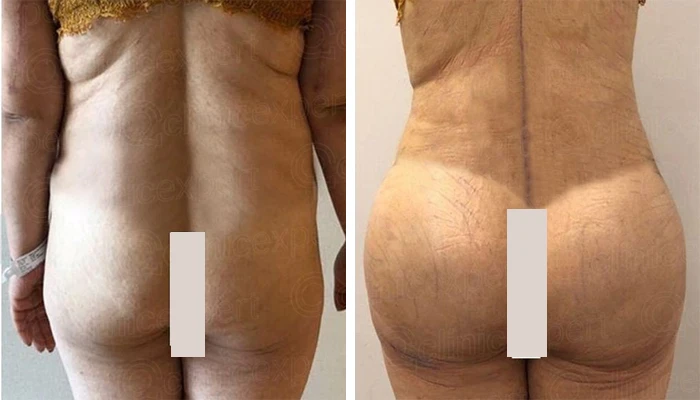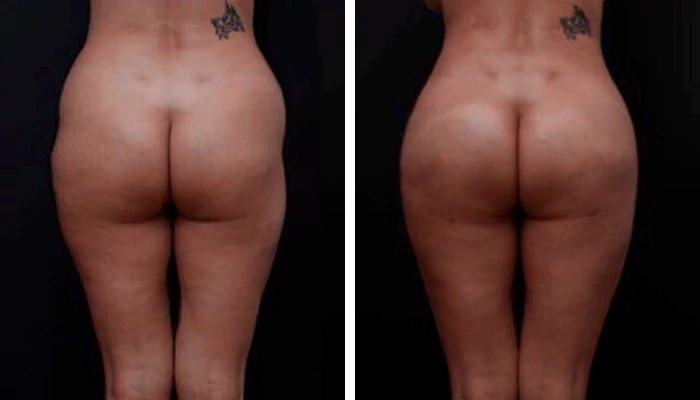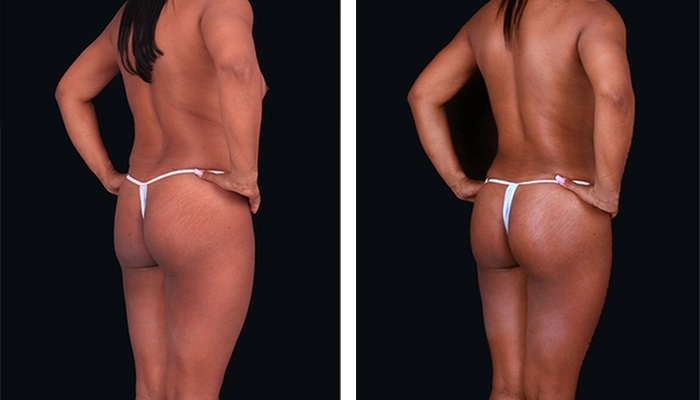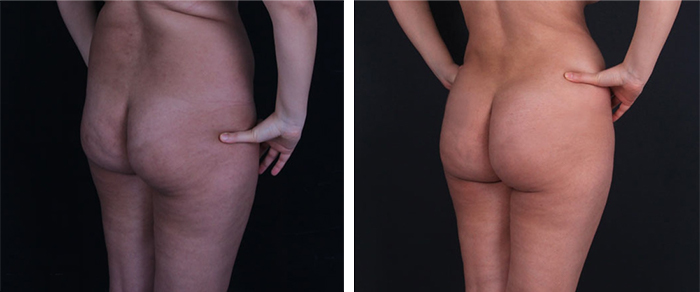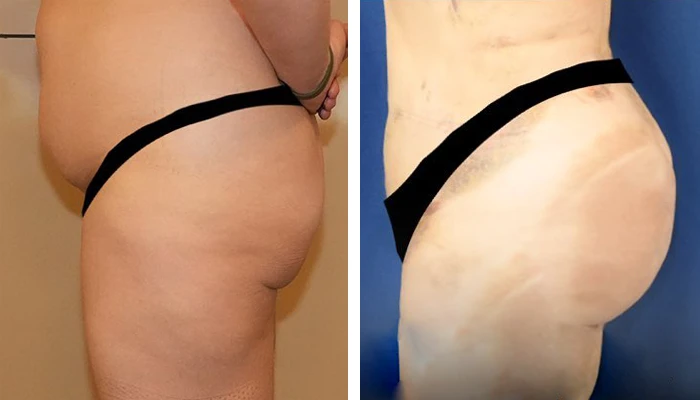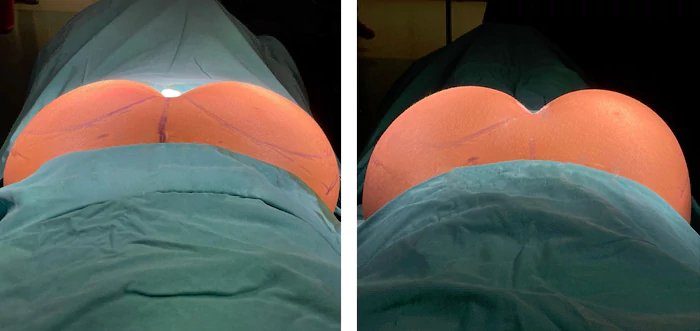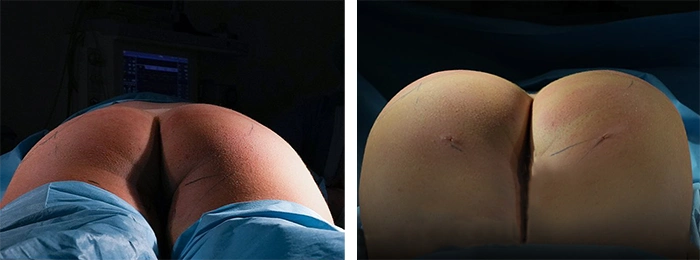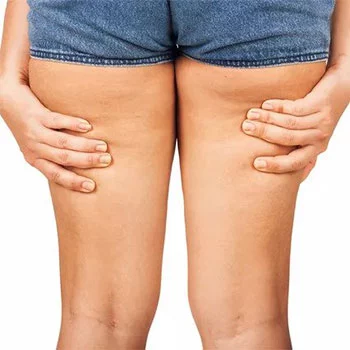What is a butt lift?
A buttock lift or butt lift, also known as a gluteal lift, is a cosmetic surgical procedure designed to lift and reshape the buttocks by removing excess skin and tissue. This procedure is typically recommended for individuals who have sagging or drooping buttocks due to factors such as aging, weight loss, or genetics.
During a butt lift, the surgeon makes incisions in the buttock crease, lower back, or hips, depending on the individual's anatomy and aesthetic goals. Excess skin and tissue are then removed, and the remaining skin is tightened and repositioned to create a lifted and more youthful appearance.
Is it the same as a Brazilian butt lift?
People often confuse a traditional butt lift with a Brazilian butt lift (BBL) due to the similarity in names and the fact that both procedures involve enhancing the appearance of the buttocks. However, it is important to recognize that these are two distinct cosmetic procedures with different techniques and goals.
While both procedures are aimed at enhancing the appearance of the buttocks, a traditional butt lift focuses on lifting and reshaping the buttocks by removing excess skin and tissue to address sagging or drooping buttocks, while a Brazilian butt lift involves a fat transfer procedure to increase the size and contour of the buttocks.
The emphasis of a traditional butt lift is on improving the contour and lift of the buttocks without significantly increasing their size. This procedure does not involve fat transfer. On the other hand, a BBL involves liposuction to remove fat from areas of the body with excess fat and then injecting that fat into the buttocks to enhance their size, shape, and contour. The primary goal of a BBL is to increase the volume and projection of the buttocks by transferring fat to create a fuller and more rounded appearance.
In this article, when referring to a "butt lift," we are specifically addressing the traditional butt lift procedure.
Who is a good candidate for a butt lift?
A good candidate for a butt lift typically includes individuals who:
- Have sagging or drooping buttocks due to aging, weight loss, or genetics.
- Are in good overall health and do not have medical conditions that may impair healing.
- Have realistic expectations about the outcomes of the procedure.
- Are non-smokers or willing to quit smoking before and after the surgery to facilitate proper healing.
- Have stable body weight, as significant fluctuations can affect the results of the procedure.
- Have specific concerns about the shape and contour of their buttocks that they wish to address through surgery.
Individuals who are specifically looking to increase the size of their buttocks may not be ideal candidates for a traditional butt lift procedure. A traditional butt lift is more geared towards improving the contour and lift of the buttocks rather than increasing their size. For those seeking buttock volume increase, a Brazilian butt lift (BBL) or butt implants may be more suitable options.
It is essential to consult with a board-certified plastic surgeon to determine if you are a suitable candidate for a butt lift. The surgeon will evaluate your medical history, perform a physical examination, and discuss your goals and expectations to create a personalized treatment plan that aligns with your aesthetic desires and overall health.
How to prepare
To prepare for a butt lift procedure, here are some general guidelines that individuals can follow:
- Consultation: Schedule a consultation with a board-certified plastic surgeon to discuss your goals, medical history, and expectations for the procedure. This is an opportunity to ask questions, address any concerns, and ensure that you are a suitable candidate for a buttock lift.
- Medical evaluation: Undergo a comprehensive medical evaluation to assess your overall health and determine if there are any underlying medical conditions that may affect the surgery or recovery process.
- Quit smoking: If you smoke, it is advisable to quit smoking several weeks before the surgery, as smoking can impair healing and increase the risk of complications.
- Medication review: Inform your surgeon about any medications, supplements, or herbal remedies you are currently taking, as some may need to be adjusted or discontinued before the procedure.
- Follow pre-operative instructions: Adhere to any pre-operative instructions provided by your surgeon, which may include guidelines on eating, drinking, and taking medications before the surgery.
- Arrange for assistance: Arrange for someone to drive you to and from the surgical facility on the day of the procedure and to assist you during the initial phase of recovery.
- Prepare your recovery space: Set up a comfortable and conducive recovery space at home with necessary items such as loose and comfortable clothing, extra pillows, and any prescribed medications.
- Follow a healthy lifestyle: Maintain a healthy diet, stay hydrated, and engage in regular physical activity leading up to the surgery to optimize your overall health and aid in the recovery process.
- Final consultation: Have a final consultation with your surgeon to go over any last-minute questions or concerns before the procedure.
It is essential to follow your surgeon's specific pre-operative instructions to ensure a smooth and successful traditional butt lift procedure and recovery. Be sure to communicate openly with your healthcare team and follow their guidance throughout the preparation process.
Butt lift procedure steps
The buttock lift procedure typically involves several key steps:
- Anesthesia: The procedure begins with the administration of anesthesia to ensure the patient's comfort and safety throughout the surgery. This may involve either general anesthesia or intravenous sedation, depending on the surgeon's recommendation and the extent of the procedure.
- Incision: The surgeon will make incisions in strategic locations, such as the top of the buttocks, the sides, or the under buttock crease, to access the underlying tissues. The incision pattern may vary based on the individual's anatomy and the desired outcome of the butt lift.
- Tissue removal and reshaping: Excess skin and tissue are then removed to lift and reshape the buttocks. The remaining tissues are tightened and repositioned to create a more lifted and youthful appearance.
- Suturing: The incisions are carefully closed with sutures to secure the newly lifted buttocks and promote proper healing.
- Drain placement (if necessary): In some cases, drains may be placed under the skin to collect excess fluids and reduce the risk of complications such as fluid accumulation.
- Dressing and compression garments: The surgeon will apply dressings to the incision sites and may recommend wearing compression garments to support the buttocks, reduce swelling, and promote proper healing.
- Recovery: After the procedure, the patient will be monitored in a recovery area to ensure a smooth transition from surgery. Instructions for post-operative care, activity restrictions, and follow-up appointments will be provided.
It is essential to note that the specific steps of a gluteal lift procedure may vary depending on the individual's unique anatomy, the surgeon's technique, and the extent of correction needed. Patients should consult with a board-certified plastic surgeon to discuss their goals, expectations, and the details of the procedure to determine the most suitable approach for achieving their desired results.
Recovery and aftercare
After a butt lift procedure, patients can expect a recovery period that involves specific care and considerations to optimize healing and results. Here are some general guidelines for recovery and aftercare following a buttock lift:
- Pain management: Pain and discomfort are common after surgery. The surgeon may prescribe pain medications or recommend over-the-counter pain relievers to manage discomfort.
- Compression garments: Wearing compression garments as instructed can help reduce swelling, support the newly lifted buttocks, and promote proper healing.
- Activity restrictions: Patients should avoid strenuous activities, heavy lifting, and prolonged sitting for a specified period as advised by the surgeon to prevent complications and support healing.
- Follow-up appointments: It is essential to attend follow-up appointments with the surgeon to monitor progress, remove sutures or drains if necessary, and address any concerns during the recovery process.
- Wound care: Proper wound care is crucial to prevent infection and promote healing. Patients should follow the surgeon's instructions for cleaning and caring for the incision sites.
- Healthy diet and hydration: Eating a nutritious diet and staying hydrated can support the healing process and overall recovery.
- Avoid smoking and alcohol: Smoking and alcohol consumption can impair healing and increase the risk of complications. It is advisable to refrain from smoking and limit alcohol intake during the recovery period.
- Gradual return to activities: Patients should gradually resume normal activities as advised by the surgeon to prevent strain on the buttocks and promote a smooth recovery.
- Results: Final results of a traditional butt lift may become more apparent as swelling subsides and the tissues settle into their new position. It is essential to be patient and follow the surgeon's recommendations for optimal outcomes.
Patients should closely follow their surgeon's post-operative instructions, attend all follow-up appointments, and communicate any unusual symptoms or concerns during the recovery period. Individual recovery experiences may vary, and it is crucial to consult with the healthcare team for personalized guidance and support throughout the healing process.
Risks and potential complications
Like any surgical procedure, a gluteal lift carries potential risks and complications, including:
- Infection: There is a risk of infection at the incision sites, which can be managed with proper wound care and, in some cases, antibiotics.
- Bleeding: Excessive bleeding during or after the surgery can occur, requiring medical attention to address and control.
- Poor wound healing: Some individuals may experience delayed wound healing, which may lead to wound separation or scarring.
- Changes in sensation: Temporary or permanent changes in sensation in the buttocks or surrounding areas may occur after a butt lift procedure.
- Asymmetry: There is a possibility of asymmetry in the buttocks' appearance, which may require revision surgery to correct.
- Fluid accumulation: Fluid buildup (seroma) or blood accumulation (hematoma) may occur and may need to be drained to prevent complications.
- Skin discoloration: Changes in skin pigmentation or discoloration at the incision sites are possible, though often temporary.
- Deep vein thrombosis (DVT): Blood clots in the deep veins of the legs can develop, posing a risk of complications if they travel to other parts of the body.
- Anesthesia risks: Adverse reactions to anesthesia, though rare, can occur and may include allergic reactions or respiratory issues.
- Unsatisfactory results: Despite the surgeon's best efforts, there is a possibility of unsatisfactory aesthetic outcomes after a butt lift, necessitating revision surgery or additional procedures.
It is crucial for individuals considering a buttock lift to thoroughly discuss the potential risks and complications with their board-certified plastic surgeon during the consultation process. By understanding the risks involved and following pre-operative and post-operative instructions carefully, patients can help minimize the likelihood of complications and support a safe and successful recovery.
Butt lift cost
The cost of a butt lift procedure can vary based on several factors, including:
- Surgeon's experience: The level of experience and expertise of the plastic surgeon performing the procedure can influence the cost.
- Geographic location: The cost of cosmetic procedures can vary significantly based on the region and location of the surgical facility.
- Facility fees: The fees associated with the surgical facility, including operating room fees, equipment costs, and staff expenses, can impact the overall cost.
- Anesthesia fees: The type of anesthesia administered during the procedure and the anesthesiologist's fees can contribute to the total cost.
- Extent of surgery: The complexity of the traditional butt lift procedure, including the amount of tissue removal and reshaping required, can affect the cost.
- Additional procedures: If additional procedures, such as liposuction or fat transfer, are performed in conjunction with the butt lift, they can add to the overall cost.
- Post-operative care: The cost of post-operative care, follow-up appointments, medications, and compression garments should also be considered.
On average, the cost of a traditional butt lift procedure in the United States ranges from $4,000 to $15,000 or more. Individuals need to consult with a board-certified plastic surgeon for a personalized assessment and cost estimate based on their specific anatomical considerations, aesthetic goals, and surgical needs. Additionally, patients should inquire about financing options, payment plans, and potential insurance coverage to help manage the cost of the procedure.
FAQs
How long does a butt lift surgery take?
The duration of a butt lift surgery can vary depending on the extent of the procedure and individual factors. On average, a butt lift surgery may take between 2 to 4 hours to complete.
Can I have a butt lift and fat injection (BBL) at the same time?
Yes, it is possible to combine a traditional butt lift with fat injection, known as a Brazilian butt lift (BBL). This approach allows for lifting, reshaping, and adding volume to the buttocks in a single procedure.
Can a butt lift and a thigh lift be combined?
Yes, a butt lift and a thigh lift can be combined in a single surgical session to address sagging skin and tissues in both buttock and thigh areas. This combination procedure can help achieve a more comprehensive body contouring result.
Will a butt lift leave scars?
Yes, a buttock lift will leave scars as incisions are made to remove excess skin and reshape the buttocks. However, a skilled surgeon will place incisions strategically to minimize visible scarring over time.
Can a sagging butt be treated without surgery?
Mild cases of a sagging butt may be improved with non-surgical treatments such as targeted exercises, skin tightening procedures, and dermal fillers. However, for significant sagging, surgical options like a butt lift may be necessary for more effective results.

